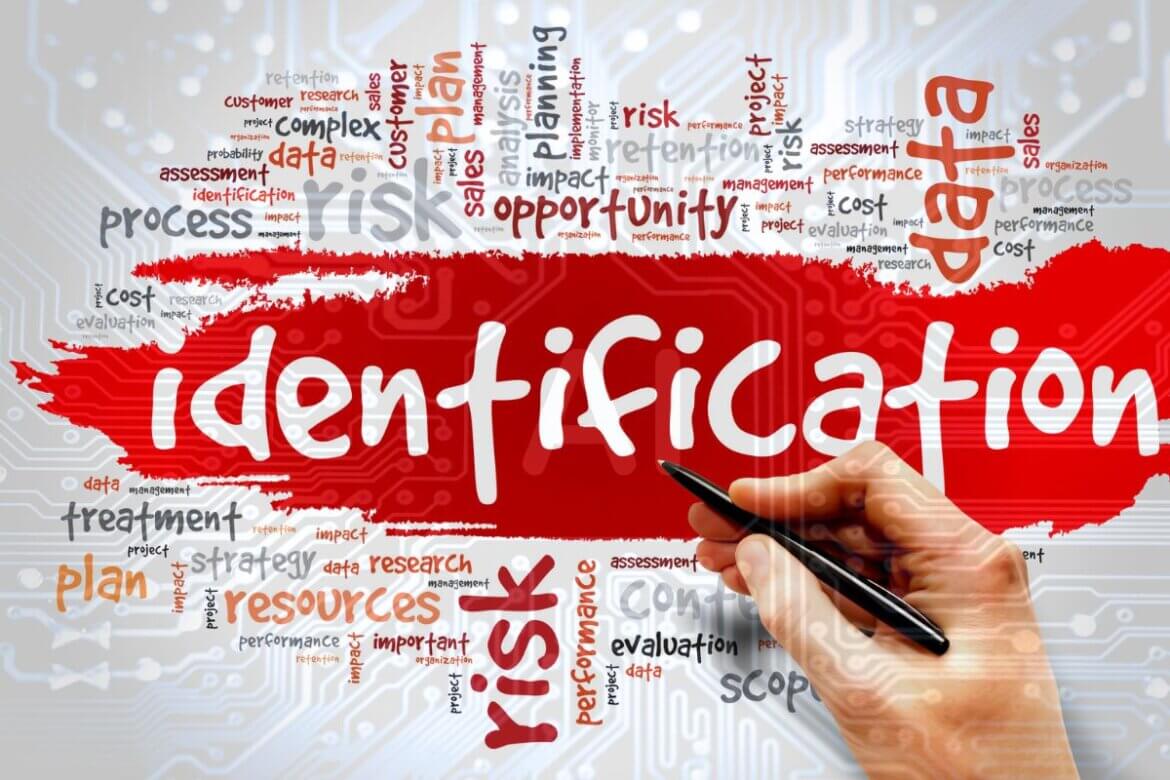
We know that risk management ensures project success by identifying and mitigating potential risks before they escalate. We also know why it can be time-consuming. With AI making progress in leaps and bounds, we decided to see how it can ease the burden on project managers for risk management. Because the topic is so vast, we decided to start with step one of risk management and talk about how Artificial Intelligence(AI) can help project managers with risk identification.
If project managers in small companies go in and actually do a risk identification analysis, they are going to be way ahead of many others in their field.
– Tom Waddell
ChatGPT is also said to be helpful in the following risk management phases:
- Risk assessment: Once risks are identified, ChatGPT can assist in assessing their potential impact and likelihood.
- Risk mitigation strategies: ChatGPT can suggest various mitigation strategies for identified risks based on historical data or best practices.
- Risk monitoring: Project managers need to set up systems to monitor the identified risks throughout the project life cycle. AI can assist in designing dashboards or alert systems for this.
- Risk communication: ChatGPT can help communicate risks effectively to stakeholders by generating clear and concise reports or presentations. It can help project managers articulate the potential impact of risks.
- Continuous improvement: By analyzing project data and feedback, it can provide insights into areas for improvement and recommend strategies to improve the effectiveness of risk management.
With this AI for risk management–beginners series, we will go into detail about each…
…starting with how AI can be used for risk identification.
While medical device development risks are project-specific, they can primarily be categorized into:
- Technical risks
- Clinical and regulatory risks
- Resource risks
- Intellectual Property(IP) risks
- Competitive risks
Project managers can use ChatGPT to identify these risks by using the correct prompts, asking the right questions, and feeding it relevant data about the project on hand.
Let’s go into detail about each one of them.
1. Using ChatGPT to identify technical risks
These risks relate to the technical aspects of designing and manufacturing the device, including but not limited to:
- Design flaws or limitations that could affect device performance or safety.
- Challenges in materials selection, manufacturing processes, or quality control.
- Compatibility issues with other medical equipment or systems.
- Difficulty in achieving regulatory compliance for new technologies or innovative designs.
Project managers can ask Chat GPT to identify technical risks commonly associated with projects similar to theirs. We asked it to identify technical risks associated with developing a biliary catheter.
Here’s what it had to say about that:
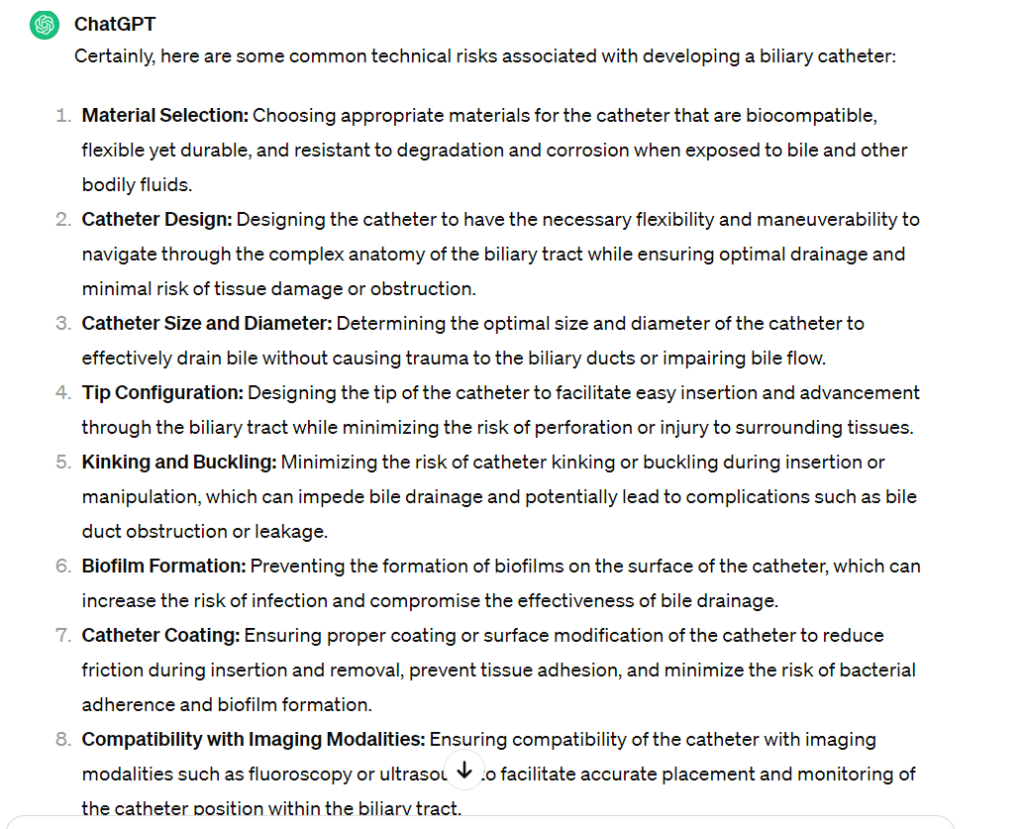
2. Identifying regulatory risks
Some examples of regulatory risks are:
- Delays or rejections in obtaining regulatory clearance or approval from health authorities.
- Changes in regulatory standards or guidelines that impact device development or market entry.
- Non-compliance with regulatory requirements, leading to penalties, recalls, or legal consequences.
Project managers can ask ChatGPT questions like: ‘What can be the possible delays in obtaining a regulatory clearance from XYZ authority for ABC products?’ Or ‘What are the recent changes in ABC regulatory guidelines that can impact the development of XYZ devices?’
The more detailed you are about your device and the regulatory requirements, the better the answer. We decided to ask the following:

As you can see, it’s very basic. We didn’t even mention the wavelengths.
Here’s how GPT helped us.
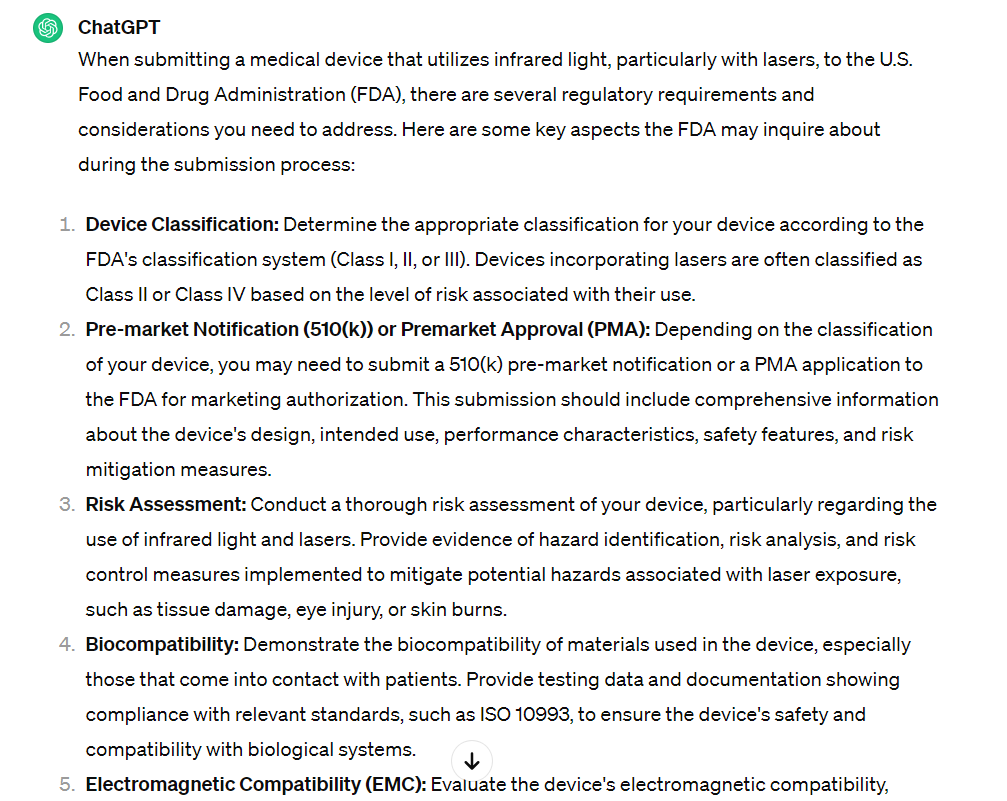
It described five other ‘key aspects’ and suggested consulting with regulatory experts. Not bad to start with. Definitely cuts down on the thinking time. But does it cover all the regulatory risks? Only a project management expert can tell.
3. Identifying resource risks
Since identifying resource risk is highly specific to a company, we won’t be able to give you a detailed example with a screenshot. However, we can give you a starting point.
Use the following prompt to ask ChatGPT what information it needs to help you identify resource risks for your company and project.
The prompt: Act as an expert project manager who needs to identify resource risks for [describe your project]. Come up with a list of questions you need the answers to, to successfully identify the resource risks associated with this project.
Once it answers, you can feed it the relevant information and ask it to identify potential resource risks.
4. Intellectual property (IP) risks
While more of a business risk than a project management risk, it helps to have some knowledge of it. IP risks include:
- Challenges in securing or enforcing patents for novel technologies or designs.
- Risk of infringement lawsuits or disputes with competitors over intellectual property rights.
- Difficulty in maintaining the confidentiality of proprietary information or trade secrets.
The ‘risk’ with using ChatGPT to help identify IP risks is that we need to feed it confidential data to get useful information. As we know, any data fed into GPT definitely doesn’t remain confidential. In the closing paragraphs, we discuss more about how to share confidential information with AI safely.
We decided to see what it does when provided with the most basic information.
Here’s what we asked for help with.

Here’s what it said
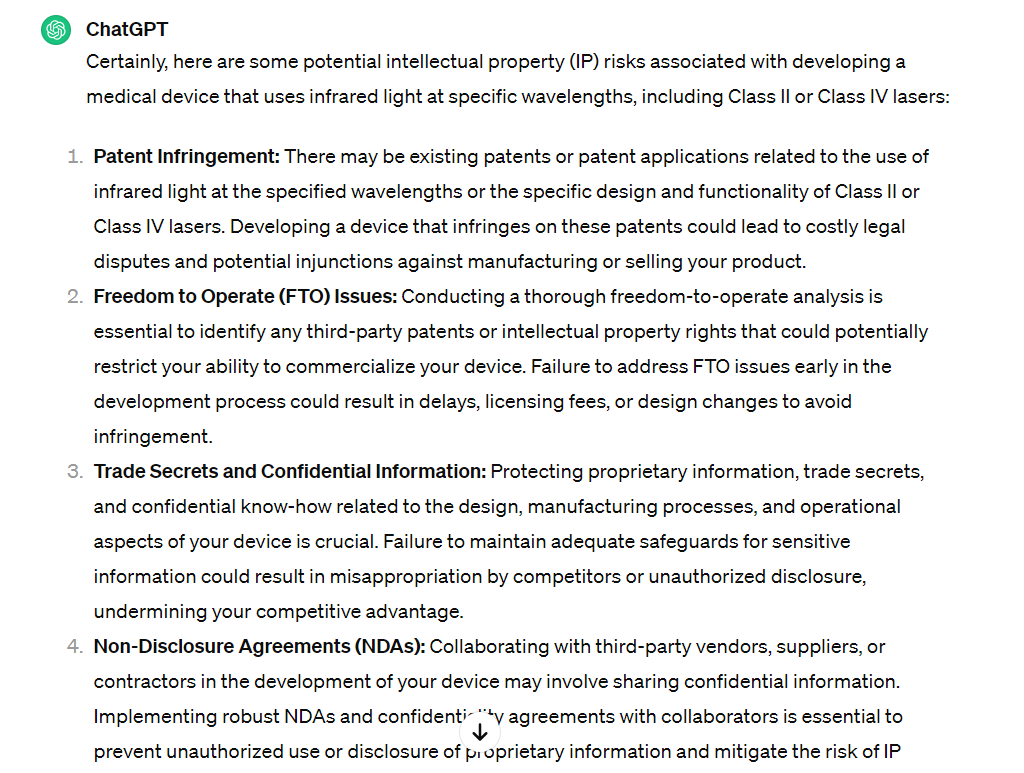
Plus 5 other IP risks. In this case, the information is generic, but it still gives you a starting point. Now you know what kind of IP risks to look out for. From here it’s easy to do your own research or communicate with the right people to know more.
5. Using ChatGPT to identify market and competitive risks
These risks apply to factors affecting the commercial success and adoption of the device. They include:
- Limited market demand or competition from existing devices or alternative treatments.
- Pricing pressures or reimbursement challenges that affect market access and profitability.
- Changes in healthcare policies, regulations, or economic conditions impacting market dynamics.
This is where it gets tricky. Generative AI does not have the latest data, so the answers it comes up with may not indicate the state of the market today.
Let’s try anyway.
Here’s the prompt we fed ChatGPT.

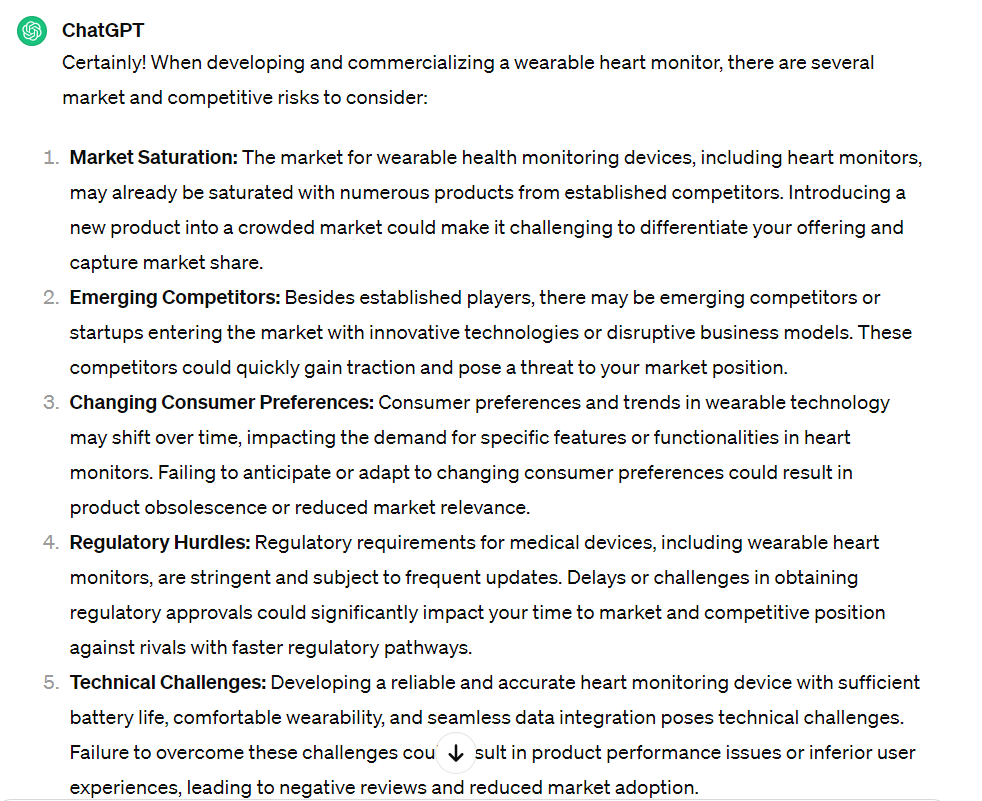
It came up with 10 responses. You can then ask it to go into detail about each one. We asked it to come up with a list of current and emerging companies for the same.

The response clearly states that the information is limited to what happened before January 2022. Some other names it mentioned were: Withings, Oura Health, WHOOP.
How can you get project-specific information from ChatGPT
As you can see from each example, Chat GPT offers helpful suggestions and generic risks that might be overlooked. However, the more specific you are with your project details, its constraints, objectives, resources available and more, the more specific responses you get. To ensure ChatGPT gives you highly detailed responses, you can actually ask it what data it needs from you, like in the image below.


Once you feed in the required information and prompt it further(for example: please give me a failure mode and effects analysis for this project), it should give you a pretty comprehensive review of the potential risks identified. Just be aware that with open-source software like Chat GPT, your data may not be secure. One way to overcome that is to build your own mini GPT with data protection and firewalls in place. There are companies out there that offer such services. It’s definitely worth looking into if you want to make full use of AI without worrying about a data leak.
We have run these queries using ChatGPT as the AI in question. You can try the same using Bing, Gemini, or other tools at your disposal.
Just remember…
These tools are fairly new. They work on data they have scraped from the World Wide Web. GPT can’t differentiate between the right and wrong information or verify if what it’s saying is true. So, you still need an experienced project manager to run these queries, sort through its responses, and come up with a comprehensive risk mitigation strategy. If you’re looking for someone like that, Waddell Group has a roster of pre-vetted project management consultants who:
- have a track record of at least five successful projects under their belt
- a minimum of ten years of project management experience
- are regarded as accomplished in their field.
- know how to get things done so your project is on time and budget
And we’d be happy to schedule a free consultation call with you to help you find the perfect fit for your project.
